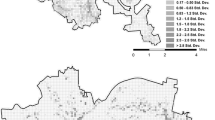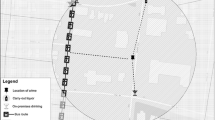I’ve been too many places. I’m like the bad penny.
(Jack Nicholson, actor)
Abstract
Crime prevention strategists have long been examining the impact of land use on crime, particularly the effects of non-residential land use in the form of facilities. Places like bars, motels, schools, convenience stores, and check-cashing centers have been examined in relation to crime to the point that it seems we now have a “criminology of the unpopular” (Wilcox and Eck in Criminol Public Policy 10(2):473–482, 2011), whereby places of a particular type are assumed to inherently offer crime opportunity. However, other theoretical and empirical work suggests that facility type may not matter and that specific characteristics and contexts associated with crime opportunity at places should be measured as opposed to assuming that broad categories of land uses typically generate crime (e.g., Brantingham and Brantingham in Stud Crime Crime Prev 8(1):7–26, 1999; Eck et al. in Crime Prev Stud 21:225, 2007; Hart and Miethe in Secur J 27(2):180–193, 2014; Smith et al. in Criminology 38(2):489–524, 2000; Wilcox and Eck in Criminol Public Policy 10(2):473–482, 2011). As an exploratory test of this latter idea, the present study uses observational data collected repeatedly at a small number of places over a one-year period—including land-use types that are not typically associated with crime (i.e., gardens)—in order to examine whether land-use parcels of the same type but with differing criminal opportunities have differing levels of crime.



Similar content being viewed by others
Notes
Hot spots are defined as “small places in which the occurrence of crime is so frequent that it is highly predictable, at least over a one year period” (Sherman 1995, p. 36).
Potentially criminogenic places were ATMs and banks, alcohol stores, bars, check-cashing stores, neighborhood corner stores, drug treatment centers, high schools, neighborhood parks, subway stops, fast-food restaurants, pawn shops, and public housing communities.
UCR data were chosen due to the difficulties in alternative crime measures. Specifically, calls for service tend to be a reflection of people’s willingness to call police rather than level of crime per se.
Due to the small sample sizes for each site type, all sites were combined (N = 41) to assess the bivariate correlations of crime rate with interval-level measures of criminal opportunity.
References
Bernasco, W., and R. Block. 2009. Where offenders choose to attack: A discrete choice model of robberies in Chicago. Criminology 47 (1): 93–130.
Bernasco, W., and R. Block. 2011. Robberies in Chicago: A block-level analysis of the influence of crime generators, crime attractors, and offender anchor points. Journal of Research in Crime and Delinquency 48 (1): 33–57.
Bevis, C., and J. Nutter. 1977 Changing street layouts to reduce residential burglary. Paper presented at American Society of Criminology annual meeting.
Block, R.L., and C.R. Block. 1995. Space, place and crime: Hot spot areas and hot places of liquor-related crime. Crime and Place 4 (2): 145–184.
Braga, A.A., D.M. Hureau, and A.V. Papachristos. 2011. The relevance of micro places to citywide robbery trends: A longitudinal analysis of robbery incidents at street corners and block faces in Boston. Journal of Research in Crime and Delinquency 48 (1): 7–32.
Brantingham, P.L., and P.J. Brantingham. 1993. Nodes, paths and edges: Considerations on the complexity of crime and the physical environment. Journal of Environmental Psychology 13 (1): 3–28.
Brantingham, P., and P. Brantingham. 1995. Criminality of place: Crime generators and crime attractors. European Journal on Criminal Policy and Research 3 (3): 5–26.
Brantingham, P.L., and P.J. Brantingham. 1999. A theoretical model of crime hot spot generation. Studies on Crime and Crime Prevention 8 (1): 7–26.
Curman, A.S., M.A. Andresen, and P.J. Brantingham. 2015. Crime and place: A longitudinal examination of street segment patterns in Vancouver, BC. Journal of Quantitative Criminology 31 (1): 127–147.
Deryol, R., P. Wilcox, M. Logan, and J. Wooldredge. 2016a. Crime places in context: An illustration of the multilevel nature of hotspot development. Journal of Quantitative Criminology 32:305–325 (Erratum, pp. 327–328).
Deryol, R., J. Wooldredge, P. Wilcox, and M. Logan. 2016b. Pondering products of place-level distances: A reply to Reinhart. Journal of Quantitative Criminology. doi:10.1007/s10940-016-9300-2.
Donnelly, P.G., and C.E. Kimble. 1997. Community organizing, environmental change, and neighborhood crime. Crime and Delinquency 43: 493–511.
Duru, H. 2010. Crime on Turkish streetblocks: An examination of the effects of high-schools, on-premise alcohol outlets, and coffeehouses. Doctoral dissertation, University of Cincinnati.
Eck, J.E., R.V. Clarke, and R.T. Guerette. 2007. Risky facilities: Crime concentration in homogeneous sets of establishments and facilities. Crime Prevention Studies 21: 225.
Eck, J.E., T. Madensen, T. Payne, P. Wilcox, B.S. Fisher, and H. Scherer. 2010. Situational crime prevention at specific locations in community context: Place and neighborhood effects. Final Report to the National Institute of Justice. NCJRS 229364.
Felson, M. 2006. Crime and nature. Thousand Oaks, CA: Sage Publications.
Greenberg, S., W. Rohe, and J. Williams. 1982. Safety in urban neighborhoods: A comparison of physical characteristics and informal territorial control in high and low crime neighborhoods. Population and Environment 5: 141–165.
Groff, E.R., D. Weisburd, and S. Yang. 2010. Is it important to examine crime trends at a local “micro” level?: A longitudinal analysis of street to street variability in crime trajectories. Journal of Quantitative Criminology 26 (1): 7–32.
Haberman, C.P., and J.H. Ratcliffe. 2015. Testing for temporally differentiated relationships among potentially criminogenic places and census block street robbery counts. Criminology 53: 457–483.
Hart, T.C., and T.D. Miethe. 2014. Street robbery and public bus stops: A case study of activity nodes and situational risk. Security Journal 27 (2): 180–193.
Hillier, B., and J. Hanson. 1984. The social logic of space. Cambridge: Cambridge University Press.
Kubrin, C.E., G.D. Squires, S.M. Graves, and G.C. Ousey. 2011. Does fringe banking exacerbate neighborhood crime rates? Criminology and Public Policy 10 (2): 437–466.
Kurtz, E., B. Koons, and R.B. Taylor. 1998. Land use, physical deterioration, resident-based control, and calls for service on urban streetblocks. Justice Quarterly 15: 121–149.
Reynald, D. 2009. Guardianship in action: Developing a new tool for measurement. Crime Prevention and Community Safety 11 (1): 1–20.
Rice, K.J., and W.R. Smith. 2002. Socioecological models of automotive theft: Integrating routine activity and social disorganization approaches. Journal of Research in Crime and Delinquency 39 (3): 304–336.
Roncek, D.W., and D. Faggiani. 1985. High schools and crime: A replication. Sociological Quarterly 26 (4): 491–505.
Roncek, D.W., and A. LoBosco. 1983. The effects of high schools on crime in their neighborhoods. Social Science Quarterly 64 (3): 598–613.
Roncek, D.W., and P.A. Maier. 1991. Bars, blocks, and crimes revisited: Linking the theory of routine activities to the empiricism of “hot spots”. Criminology 29 (4): 725–753.
Sampson, R.J. 2012. Great American city: Chicago and the enduring neighborhood effect. Chicago: The University of Chicago Press.
Shaw, C.R., and H.D. McKay. 1942. Juvenile delinquency and urban areas. Chicago, IL: The University of Chicago Press.
Sherman, L.W. 1995. Hot spots of crime and criminal careers of places. Crime and Place 4: 35–52.
Sherman, L.W., P.R. Gartin, and M.E. Buerger. 1989. Hot spots of predatory crime: Routine activities and the criminology of place. Criminology 27 (1): 27–56.
Smith, W.R., S.G. Frazee, and E.L. Davison. 2000. Furthering the integration of routine activity and social disorganization theories: Small units of analysis and the study of street robbery as a diffusion process. Criminology 38 (2): 489–524.
SooHyun, O., and Y. Lee. 2016. Crime and land use in Pittsburgh: A micro-size grid-cell analysis of the influence of land-uses on area crime. Crime Prevention and Community Safety 18 (3): 204–227.
Stuckey, T.D., and J.R. Ottensmann. 2009. Land use and violent crime. Criminology 47 (4): 1223–1264.
Taylor, R.B., and A. Harrell. 1996. Physical environment and crime. US Department of Justice, Office of Justice Programs, National Institute of Justice. NCJ 157311.
Weisburd, D., S. Bushway, C. Lum, and S. Yang. 2004. Trajectories of crime at places: A longitudinal study of street segments in the city of Seattle. Criminology 42 (2): 283–321.
Weisburd, D.L., E.R. Groff, and S. Yang. 2012. The criminology of place: Street segments and our understanding of the crime problem. New York, NY: Oxford University Press.
White, G.F. 1990. Neighborhood permeability and burglary rates. Justice Quarterly 7: 57–67.
Wilcox, P., and J.E. Eck. 2011. Criminology of the unpopular. Criminology and Public Policy 10 (2): 473–482.
Wilcox, P., N. Quisenberry, D.T. Cabrera, and S. Jones. 2004. Busy places and broken windows? Toward defining the role of physical structure and process in community crime models. The Sociological Quarterly 45 (2): 185–207.
Author information
Authors and Affiliations
Corresponding author
Rights and permissions
About this article
Cite this article
Blair, L., Wilcox, P. & Eck, J. Facilities, opportunity, and crime: An exploratory analysis of places in two urban neighborhoods. Crime Prev Community Saf 19, 61–81 (2017). https://doi.org/10.1057/s41300-016-0011-2
Published:
Issue Date:
DOI: https://doi.org/10.1057/s41300-016-0011-2




